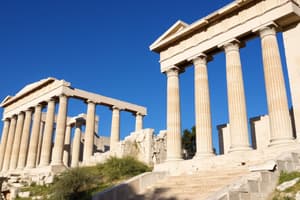Podcast
Questions and Answers
Which of these geographical features was NOT located near Sparta?
Which of these geographical features was NOT located near Sparta?
- Arcadian Mountains
- Taygetus Mountains
- Parnon Mountains
- Mount Olympus (correct)
What was the primary reason for the lack of written sources about Sparta's major historical changes between 900 and 600 BC?
What was the primary reason for the lack of written sources about Sparta's major historical changes between 900 and 600 BC?
- The Spartans did not have a written language
- The Spartans were illiterate during that period
- The Spartans were not interested in recording their history
- Limited written sources survive from that period (correct)
Which ancient Greek writer specifically focused on political observations in their descriptions of Sparta?
Which ancient Greek writer specifically focused on political observations in their descriptions of Sparta?
- Xenophon
- Plato and Aristotle (correct)
- Herodotus
- Thucydides
Based on Thucydides' perspective, what aspect of Sparta's physical appearance likely contributed to its perceived power?
Based on Thucydides' perspective, what aspect of Sparta's physical appearance likely contributed to its perceived power?
What does Thucydides imply about the relationship between a city's physical appearance and its perceived power?
What does Thucydides imply about the relationship between a city's physical appearance and its perceived power?
What is the primary reason for Thucydides' argument that future generations would find it difficult to believe in Sparta's past power?
What is the primary reason for Thucydides' argument that future generations would find it difficult to believe in Sparta's past power?
How does the example of Athens contribute to Thucydides' argument about Sparta's perceived power?
How does the example of Athens contribute to Thucydides' argument about Sparta's perceived power?
Which of the following Spartan sites would most likely have been considered a significant marker of the city's power based on Thucydides' views?
Which of the following Spartan sites would most likely have been considered a significant marker of the city's power based on Thucydides' views?
Based on Thucydides' perspective, what would be the most significant factor in determining Sparta's true power for future generations?
Based on Thucydides' perspective, what would be the most significant factor in determining Sparta's true power for future generations?
How does Thucydides' perspective challenge the traditional view of Sparta's strength as primarily based on its military prowess?
How does Thucydides' perspective challenge the traditional view of Sparta's strength as primarily based on its military prowess?
Outline the key features of the site of Sparta
Outline the key features of the site of Sparta
Flashcards
Thucydides on Sparta
Thucydides on Sparta
Thucydides noted Sparta's lack of grandeur could mislead future generations about its power.
Acropolis of Sparta
Acropolis of Sparta
The fortified citadel of ancient Sparta, significant for religion and military.
Sanctuary of Artemis Orthia
Sanctuary of Artemis Orthia
An important religious site in Sparta dedicated to Artemis, known for rituals.
Menelaion
Menelaion
Signup and view all the flashcards
Spartan Agoge
Spartan Agoge
Signup and view all the flashcards
Sparta's Architecture
Sparta's Architecture
Signup and view all the flashcards
Hellenic Villages
Hellenic Villages
Signup and view all the flashcards
Geographical Location of Sparta
Geographical Location of Sparta
Signup and view all the flashcards
Rival City-States
Rival City-States
Signup and view all the flashcards
Taygetus Mountain Range
Taygetus Mountain Range
Signup and view all the flashcards
Eurotas River
Eurotas River
Signup and view all the flashcards
Laconian Plain
Laconian Plain
Signup and view all the flashcards
Spartan Society Changes
Spartan Society Changes
Signup and view all the flashcards
Ancient Writers
Ancient Writers
Signup and view all the flashcards
Spartan Agriculture
Spartan Agriculture
Signup and view all the flashcards
Study Notes
Geographical Location of Sparta
- Situated in southeastern Peloponnese, Greece
- Rivalled Athens and Thebes in size through subjugating Messenia
- Located on the Laconia plain
- Surrounded by mountains: Taygetus (west), Parnon (east), Arcadian (north)
- The Eurotas River provided water
- Small Laconian plain allowed for food production
- Laconian area: rugged, mountainous, waterless limestone
- Soil of the plain: fertile, but stones from mountains made cultivation difficult, suited to fruit trees and vines better than grains
- Well-watered by streams from Taygetus and springs
- Scarce wheat land (temperate climate), barley was the staple grain
- Uplands suitable for sheep farming
- Olives grown on lower mountain slopes
- Taygetus provided timber and game
- Marble, iron, and lead were mined
- Shellfish for purple dye found in Laconian Gulf
Ancient Writers on Sparta
- Limited contemporary written sources (c. 900-600 BC) for understanding social changes
- Archaeological evidence is also limited regarding the causes and nature of these changes
- Primary evidence for Sparta comes from 5th and 4th centuries BC accounts, including historians (Herodotus, Thucydides, Xenophon) and political observers (Plato, Aristotle) — all non-Spartan
Thucydides's Opinion on Sparta
- Thucydides believed Sparta's power was underestimated, likely due to its simple, non-monumental layout
- Contrasted this with Athens, arguing it appeared much more powerful than it actually was due to impressive architecture
- Thucydides believed Sparta's appearance did not reflect its immense power
Significant Sites in Sparta
- Acropolis of Sparta: Fortified citadel, less grand than Athenian Acropolis, but held religious and military importance
- Sanctuary of Artemis Orthia: Religious site dedicated to Artemis, site of rituals and competitions
- Menelaion: Shrine dedicated to Menelaus, linked to legendary Spartan past
- Spartan Agoge: Rigorous training program for Spartan boys, including military training, physical fitness, and endurance
Studying That Suits You
Use AI to generate personalized quizzes and flashcards to suit your learning preferences.




